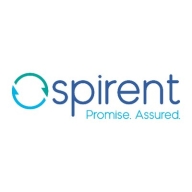

OpenText Core Application Security and Spirent CyberFlood compete in the cybersecurity solutions marketplace. OpenText holds an advantage in ease of deployment, whereas Spirent's extensive feature set makes it a strong candidate in feature capabilities.
Features: OpenText Core Application Security provides streamlined integration with existing systems, robust threat detection, and adaptability for dynamic environments. Spirent CyberFlood boasts extensive security testing capabilities, real-time traffic modeling, and advanced testing features.
Room for Improvement: OpenText could enhance its feature set to match more comprehensive security testing protocols. It may also benefit from offering more detailed real-time analytics. Spirent CyberFlood should improve its user interface to be more intuitive, simplify deployment processes, and offer more budget-friendly solutions.
Ease of Deployment and Customer Service: OpenText offers a user-friendly deployment model backed by comprehensive support, making it highly adaptable. Spirent, while having a robust support structure, requires more technical knowledge for deployment, contrasting with OpenText's user-centric approach.
Pricing and ROI: OpenText Core Application Security is known for lower setup costs and faster ROI, appealing to budget-conscious operations. Spirent CyberFlood requires a higher initial investment, justified by its advanced capabilities and significant long-term value.
| Product | Market Share (%) |
|---|---|
| OpenText Core Application Security | 3.9% |
| Spirent CyberFlood | 0.3% |
| Other | 95.8% |


| Company Size | Count |
|---|---|
| Small Business | 16 |
| Midsize Enterprise | 8 |
| Large Enterprise | 43 |
OpenText Core Application Security offers robust features like static and dynamic scanning, real-time vulnerability tracking, and seamless integration with development platforms, designed to enhance code security and reduce operational costs.
OpenText Core Application Security is a cloud-based, on-demand service providing accurate and deep scanning capabilities with detailed reporting. Its integrations with development platforms ensure an enhanced security layer in the development lifecycle, benefiting users by lowering operational costs and facilitating efficient remediation. The platform addresses needs for intuitive interfaces, API support, and comprehensive vulnerability assessments, helping improve code security and accelerate time-to-market. Despite its strengths, challenges exist around false positives, report clarity, and language support, alongside confusing pricing and package options. Enhancements are sought in areas like CI/CD pipeline configuration, report visualization, scan times, and integration with third-party tools such as GitLab, container scanning, and software composition analysis.
What features define OpenText Core Application Security?Industries like mobile applications, e-commerce, and banking leverage OpenText Core Application Security for its ability to identify vulnerabilities such as SQL injections. Integrating seamlessly with DevSecOps and security auditing processes, this tool supports developers in writing safer code, ensuring secure application deployment and enhancing software assurance.
Spirent’s revolutionary CyberFlood security and application testing solution is now available as a virtual platform offering you simplified use, by consolidating multiple test functions into a completely virtual test environment.
We monitor all Application Security Tools reviews to prevent fraudulent reviews and keep review quality high. We do not post reviews by company employees or direct competitors. We validate each review for authenticity via cross-reference with LinkedIn, and personal follow-up with the reviewer when necessary.